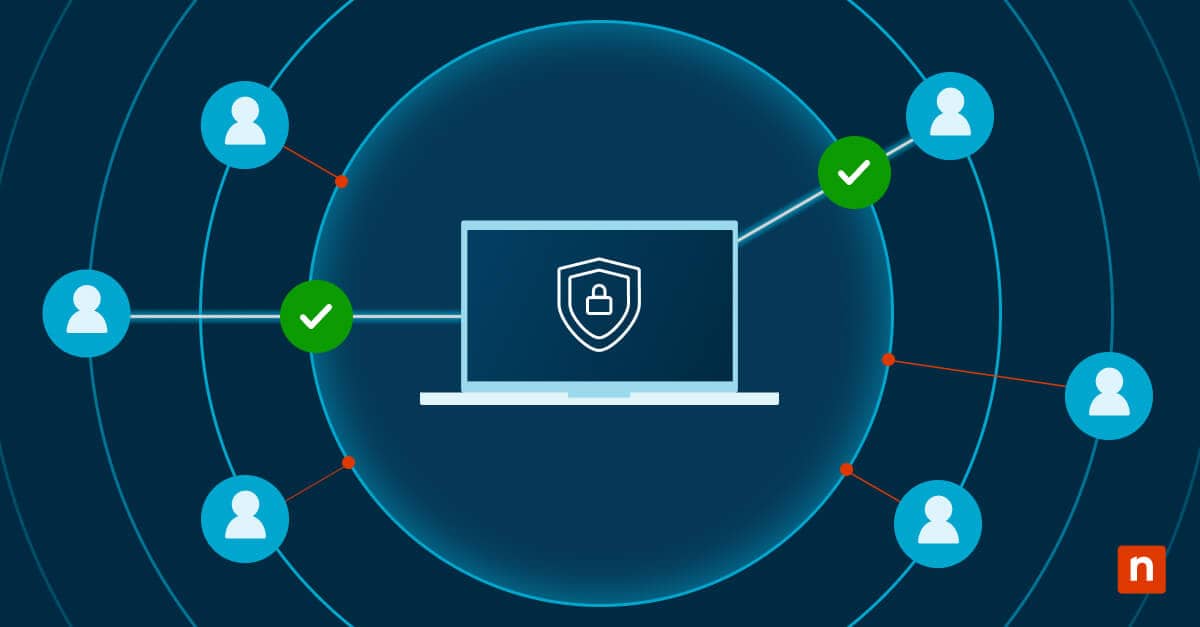Automount in Windows 10 is a relatively unknown feature that automatically mounts (or stacks) new volumes, such as external hard drives, USB drives, or virtual hard disks, when they are connected to the system. Once these volumes are mounted, they are assigned a drive letter to make them more accessible through File Explorer or other applications.
But before we jump into the instructions, it’s a good idea to talk about why disabling Automount in Windows 10 may actually be more beneficial for your organization:
Why disable Automount Windows?
While most IT guides on “What is Automount in Windows?” yield countless articles on its benefits, fewer reviews talk about why disabling it may actually be useful. This is true especially if you’re an MSP or part of a larger IT enterprise. There are two main reasons why you may want to disable Automount in Windows 10:
- Improved security: If you’re in an environment where multiple users can access the same system, automatically mounting external drives can pose security risks. Disabling Automount would be recommended to prevent unauthorized access to potentially malicious or unverified storage devices.
- Virtualization and SAN configurations: Automatic mounting can lead to conflicts or unintended drive letter assignments in virtualized environments or systems using Storage Area Networks (SANs).
Enabling or disabling Automount in Windows 10
Method 1: Using DiskPart (command line)
DiskPart is a command-line utility that allows for advanced disk management.
- Open DiskPark
- Press Windows + X and select Command Prompt (Admin) or Windows Terminal (Admin).
- Type diskpart and press Enter to launch the DiskPart utility.
- Check Automount status
- At the DISKPART> prompt, type automount, and press Enter.
- The current status of Automount (enabled or disabled) will be displayed.
- Enable or disable Automount
- To enable: Type automount enable and press Enter.
- To disable: Type automount disable and press Enter.
- Optional: Clear existing mount points
- To remove all existing mount points, type automount scrub and press Enter. This clears volume point directories and Registry settings for volumes that are no longer connected to the system.
- Exit and restart
- Type exit and press Enter to close DiskPart.
- Restart your computer for the changes to take effect.
Method 2: Using Registry Editor
- Open Registry Editor by pressing Windows + R, typing regedit, and clicking Enter.
- Navigate to the following path:
- HKEY_LOCAL_MACHINE\SYSTEM\CurrentControlSet\Services\mountmgr
- In the right-hand pane, locate the registry value, NoAutoMount.
- If it doesn’t exist
- Create it by right-clicking on an empty space
- Select New > DWORD (32-bit) Value
- Name it NoAutoMount.
- If it doesn’t exist
- Double click on NoAutoMount and set the value data:
- 1 to disable AutoMount
- 0 to enable AutoMount
- Close the Registry Editor and restart your computer for the changes to take effect.
Troubleshooting & tips
Drives not showing up after enabling Automount
If you’ve enabled Automount but new drives still don’t appear in File Explorer, it’s likely that the changes you’ve made haven’t fully taken effect yet.
To resolve this, restart your computer after enabling Automount using either DiskPark or the Registry Editor. If the reboot doesn’t solve the issue, confirm that the drive is being recognized at the hardware level. To do this, check Device Manager under Disk drives to verify it is listed. If the drive appears but has no drive letter, you can assign one manually in Disk Management.
Disk management shows “healthy” but no drive letter assigned
You might encounter a situation where a disk is detected as “healthy” in Disk Management, but it’s not assigned a drive letter and is therefore inaccessible in File Explorer.
This can happen if Automount is disabled or if the drive was previously configured without a drive letter.
To resolve this:
- Manually assign a drive letter.
- Right-click the volume in Disk Management and choose Change Drive Letter and Paths.
- In the dialog that appears, click Add and choose an available letter.
Automount scrub removed mount points for all volumes
If you’ve run automount scrub, your system may no longer recognize previously mounted drives under their old paths.
To resolve this:
- Reassign drive letters manually using Disk Management.
- Right-click the volume and select Change Drive Letter and Paths.
- Click on Add, and specify the desired empty NTFS folder path.
New drives detected in BIOS but not in Windows
This is most likely due to the drive not being initialized or formatted correctly.
To resolve this, open Disk Management and look for any Unknown or Not Initialized disks. If anything appears, right-click on the drive, choose Initialize Disk, then create a new volume using the New Simple Volume wizard. This allows you to partition and format the disk and make it usable by your operating system.
⚠️ Note: that initialization will erase any data already on the disk, so proceed with caution—especially if the drive holds business-critical data.
Automount settings keep reverting after reboot
If your Automount settings are correctly applied but keep reverting after every restart, Group Policy or third-party management tools may be overriding your changes.
To resolve this:
- Check for any active Group Policy Objects (GPOs) that might reset storage or volume policies at startup.
- Use the gpresult /h report.html command in an elevated Command Prompt to generate a summary of active policies.
- In addition, verify that no startup scripts or remote management tools (such as those used in MSP environments) are forcing rollbacks.
- If found, contact your endpoint management provider to update their tools and preserve your Automount settings.
FAQs on configuring Automount in Windows 10
What exactly does Automount do in Windows?
Automount automatically assigns drive letters to newly connected storage devices. When enabled, it ensures that USB drives, external hard drives, and other volumes appear in File Explorer shortly after being plugged in. It simplifies disk management for most users by making newly added volumes available immediately without requiring manual intervention.
When it is disabled, Windows detects new disks but does not automatically assign drive letters to external volumes.
Is it safe to disable Automount on production systems?
Yes. In fact, it may even be recommended, especially if you’re in a highly regulated industry. Many IT professionals intentionally disable Automount to prevent unauthorized storage devices from being accessed or interfering with system configurations.
Can I enable Automount for specific devices only?
No. Windows 10 does not offer an option to selectively enable Automount for specific devices while disabling it for others. Keep in mind that Automount operates as a global system setting.
Even so, you can work around this by disabling Automount and then manually mounting only the trusted devices you wish to use (see below).
How do I manually mount a drive when Automount is disabled?
Right-click the Start menu, select Disk Management, locate the unmounted volume, right-click it, and select Change Drive Letter and Paths. From there, click Add and choose a drive letter.
Will disabling Automount affect network drives or mapped drives?
No. Disabling Automount does not affect mapped network drives. Automount only governs the behavior of local and removable physical or virtual disks when they are newly connected to the system.
Configuring Automount in Windows 10
The Automount is a convenient feature in Windows 10 that simplifies the process of accessing new storage devices. However, it may be distracting and even potentially dangerous for companies that work in tightly controlled environments. Understanding how to enable or disable Automount ensures better control over your system’s storage behavior and security.







